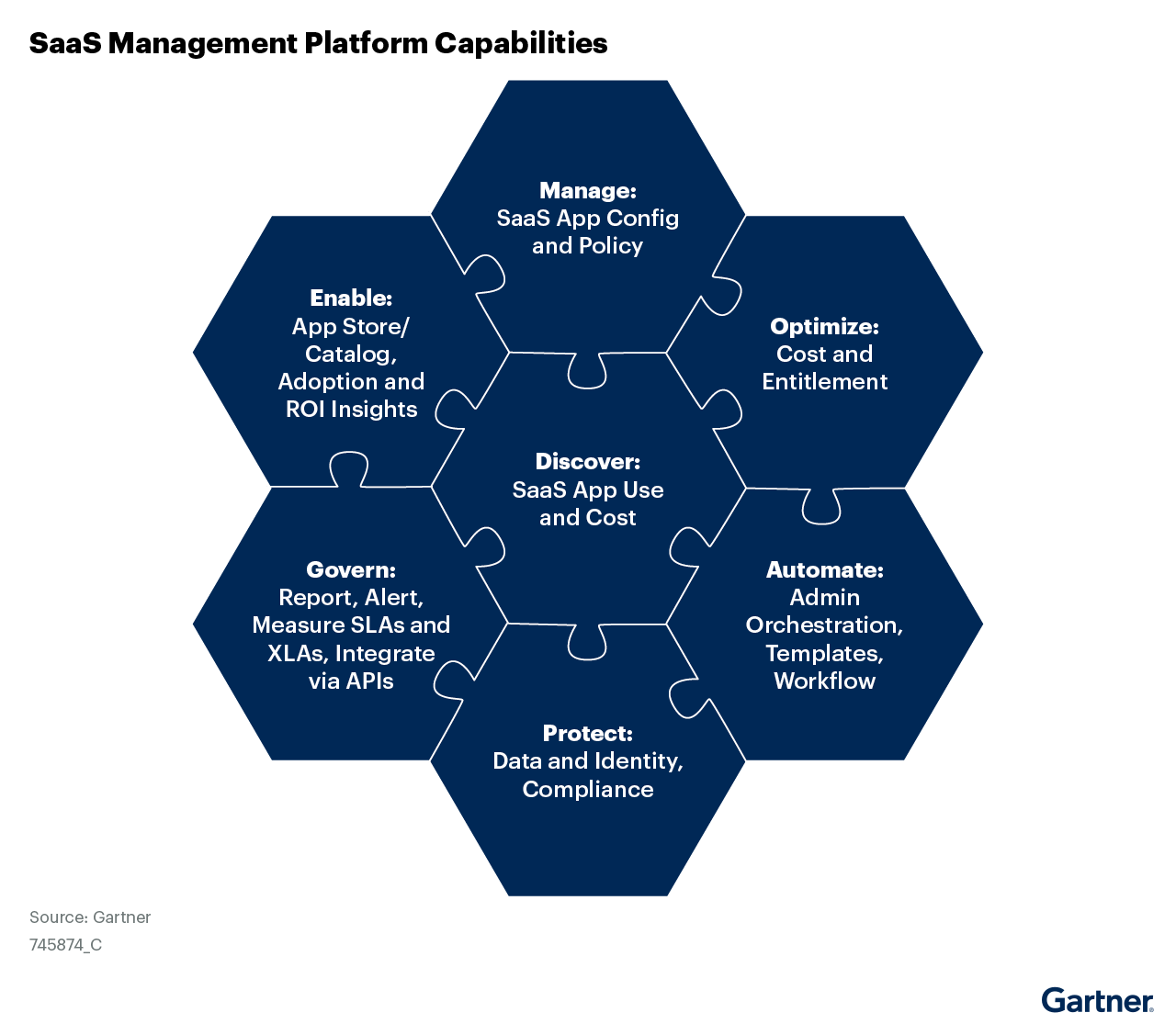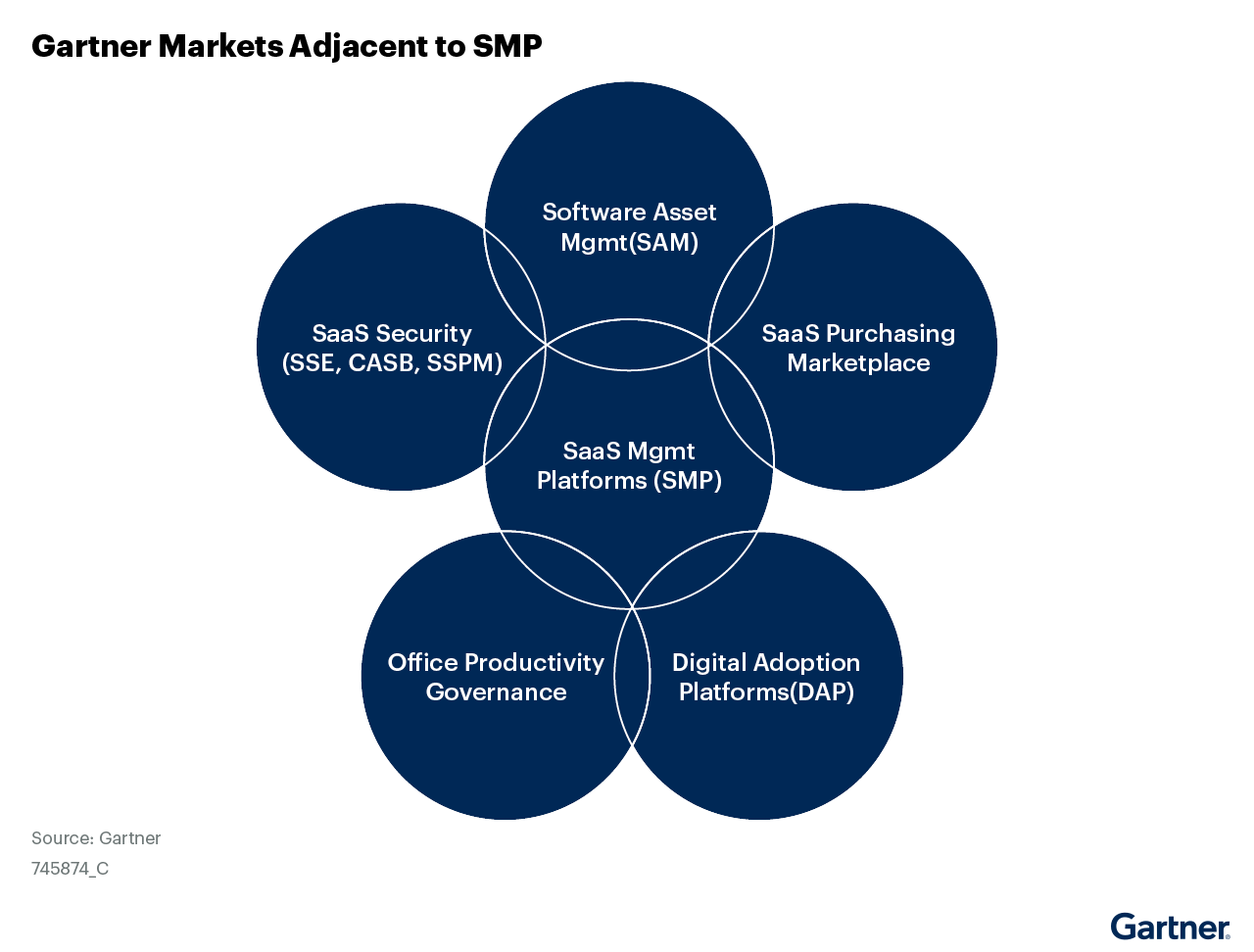SaaS Management
• 4 min read
Key Takeaways from the Gartner® Market Guide for SaaS Management Platform 2023
17th August, 2023
SHARE ON:
The 2023 Gartner Market Guide illustrates the importance of implementing a SaaS Management Platform and the challenges organizations can resolve.
With the proliferation of SaaS applications across different departments, organizations need visibility into their SaaS stack to maintain compliance, control costs, and protect data.
One key takeaway from the report is that “SaaS spend continues to grow by 15-20% annually, as organizations maintain an average of over 125 different SaaS applications, totaling $1,040 per employee annually. Due to decentralized ownership and sourcing, IT typically knows only a third of those.” Further stating that “Managing multi-SaaS environments with disparate consoles result in sprawl, lack of control, and overspending.”
The Gartner insights voice echoes the urgency: “Growing financial, security, and operational risks are posed by IT’s inability to discover, govern, and enable SaaS, automate management tasks, optimize costs and licenses, and protect data and identity.”
7 Core Capabilities of a SaaS Management Platform
The landscape of SaaS Management Platforms (SMPs) has evolved, with their core functions adapting to the dynamic demands of modern organizations. According to the Gartner research, the below Figure 1 graphic represents the seven critical capabilities of SaaS management platforms.

Discover: Uncover sanctioned and unsanctioned SaaS use and cost.
Manage: Centralize multi-SaaS configuration and policy management within a single console.
Optimize: Analysis, insights, alerting, and automation to optimize SaaS cost and entitlement (licenses).
Automate: Simplify SaaS administration with turnkey configuration and policy templates, workflow engine, and intelligence-driven actions powered by AI/ML.
Protect: Analysis, insights, alerting, and automation to protect organizational identities and data within SaaS. Also includes ensuring SaaS policies and configurations are compliant with corporate, security, or regulatory standards.
Govern: Foundational capabilities that include reporting, alerting, and measuring.SaaS availability and the breadth and depth of integrations with SaaS apps and other IT tools.
Enable: Availability of an employee-facing application store or catalog to simplify SaaS requests. In addition, analysis, insights, and alerting to help drive SaaS adoption and maximize ROI.
As the market matures, companies are highly likely to use an SMP tool for discovery, management, IT employee onboarding, and optimization of cloud applications to improve internal operations.
Notably, the demand for SMPs has surged considerably. The Gartner Strategic Planning Assumptions state, “By 2027, 40% of organizations using multiple SaaS applications will centralize management using an SMP, an increase from less than 25% in 2022.”
SMPs provide a central place to harmonize data protection policies, entitlements, and access controls for multiple SaaS applications.
The Rise of Adjacent Market Solutions for an SMP
Gartner says, “There are several adjacent or complementary technology markets to consider when starting with SaaS discovery (see Figure 2). These often provide some, but not all, SMP capabilities. To build momentum before acquiring a new tool, end-user clients should scan for the presence of these complementary technologies that can aid their efforts:

Software Asset Management (SAM):
Despite SAM tools increasingly being promoted by vendors as SMPs, they offer incomplete capabilities. Most can discover and optimize, and some can govern, but they are generally limited to discovery on managed devices (not personal or mobile). Most also lack the functionality to manage, automate, protect, or enable SaaS.
SaaS Security: This includes (but is not limited to) CASB, SSPM, and SSE solutions. They can discover, protect, and restrict access based on assessed risk, conditional access policies, or defined business rules but lack the functionality to manage, automate, optimize, or enable SaaS.
SaaS Purchasing Marketplaces: Sometimes included with SAM tools or
SAM managed services, these offerings can broker and negotiate SaaS
purchases on your behalf and manage contracts, costs, and consumption. They
offer the basic ability to optimize and govern, but lack the ability to completely
discover, manage, automate, protect, or enable SaaS.Digital Adoption Platform (DAP): DAPs are purposely built to analyze, measure, and optimize employee adoption of applications, including SaaS. This overlap is limited primarily to some capabilities for discovery, optimization, governance, and enablement and lacks the ability to manage, automate, and protect.
Office Productivity Governance: Despite SMP evolving from these tools and many vendors being represented in previous Market Guides, these are primarily or exclusively focused on Google Workspace and Microsoft 365. They have integrations with other SaaS apps for migrating data but cannot address all seven of the key features in a multi-SaaS environment. Gartner still recommends office productivity governance tools to supplement native Google and Microsoft capabilities.”
Closing Thoughts on SaaS Adoption:
Gartner foresees a rising trend in organizations adopting SaaS Management Platforms (SMPs). By 2027, it is predicted that 40% of companies with multiple SaaS applications will opt for centralized management using an SMP, up from less than 25% in 2022.
As enterprises strive to stay ahead in the realm of SaaS, SMPs will emerge as indispensable allies. Their ability to discover, manage & optimize, automate, and secure SaaS landscapes position businesses for success. This makes SMPs essential for the modern enterprise to navigate the complex web of SaaS.
The aforementioned insights represent a concise overview of the complete report. If you would like to receive a complimentary copy of the complete Market Guide for SaaS Management Platforms, you can access it by clicking here.
To learn more about how Zluri can manage, discover, govern, optimize, and automate your SaaS ecosystem, click here for a demo.
Your journey toward streamlined SaaS management begins here!
Gartner, Market Guide for SaaS Management Platforms, Dan Wilson, Jaswant Kalay, Tom Cipolla, Joe Mariano, 13 December 2022. GARTNER is a registered trademark and service mark of Gartner, Inc. and/or its affiliates in the U.S. and internationally and is used herein with permission. All rights reserved. Gartner does not endorse any vendor, product, or service depicted in its research publications and does not advise technology users to select only those vendors with the highest ratings or other designation. Gartner research publications consist of the opinions of Gartner’s research organization and should not be construed as statements of fact. Gartner disclaims all warranties, expressed or implied, with respect to this research, including any warranties of merchantability or fitness for a particular purpose.
Related Blogs
See More
Subscribe to our Newsletter
Get updates in your inbox
